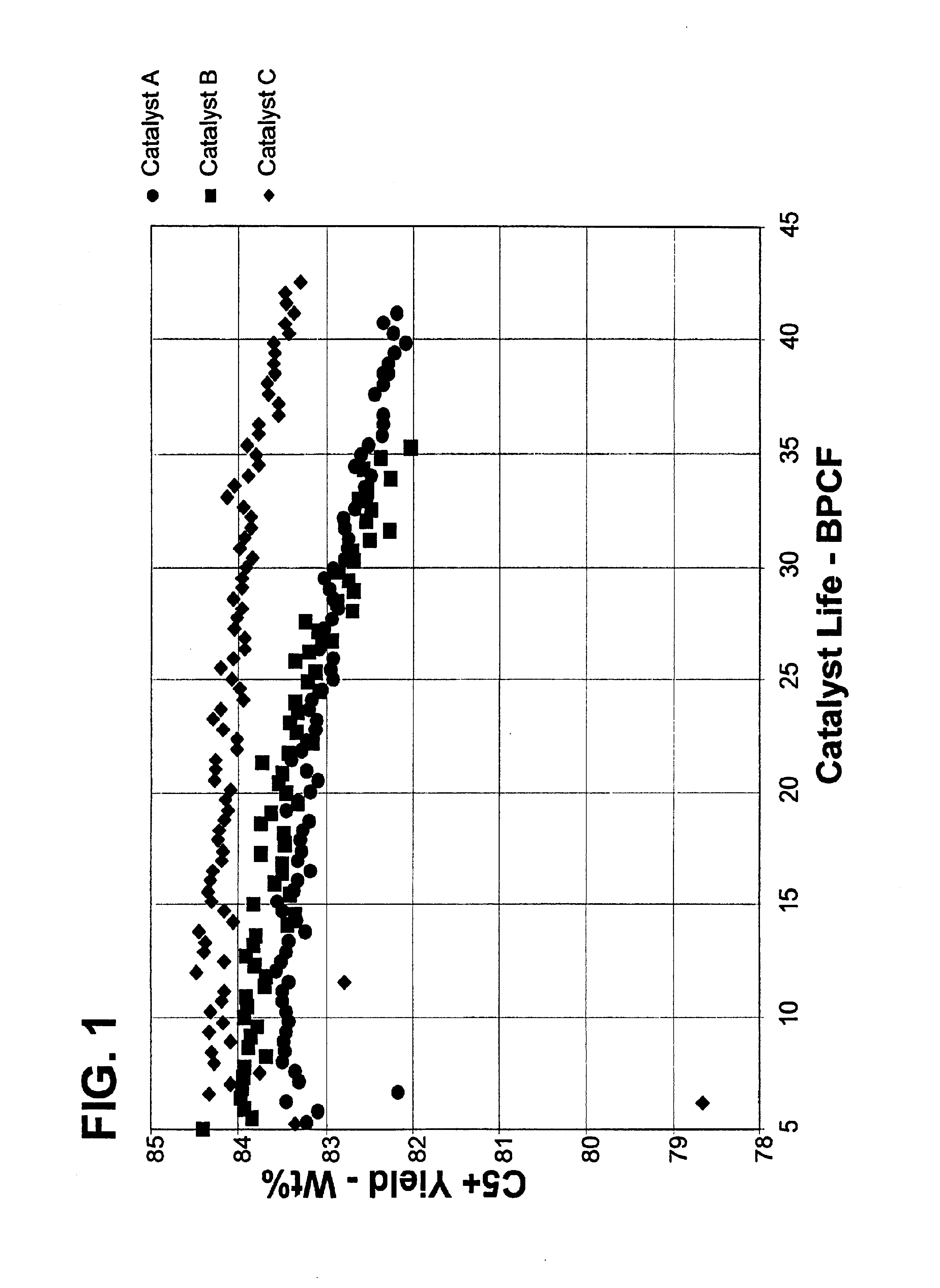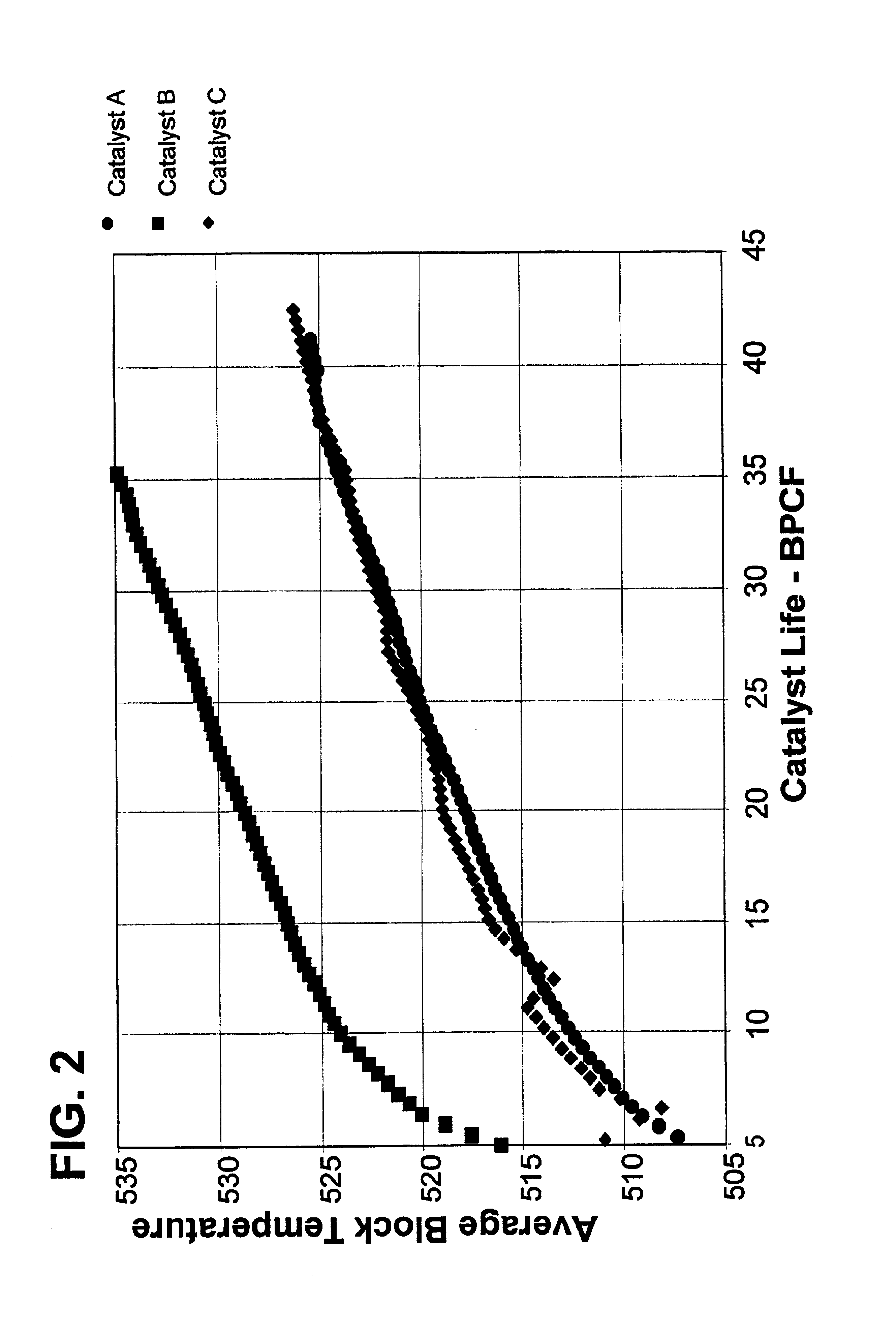Reforming catalyst with chelated promotor
a catalyst and promotor technology, applied in the field of catalysts, can solve the problems of reducing the yield of products boiling in the gasoline range, and achieve the effect of reducing the calcined catalys
- Summary
- Abstract
- Description
- Claims
- Application Information
AI Technical Summary
Benefits of technology
Problems solved by technology
Method used
Image
Examples
example 1
Tin was added to the support when as part of the forming process called extrusion, or preferably co-extrusion. 2500 g of alumina powder (commercially available under the trade names Catapal B and / or Versal 250) was added to a mixer. A solution was prepared using 60.8 g nitric acid (67.5% HNO3) with 220 g deionized water, followed by the addition of 5.91 g of tin tartrate, and the solution was stirred. The solution was added to the alumina powder in the mixer, and mulled to make a dough suitable for extrusion. The dough was extruded through a die plate to form extrudate particles. The extrudate particles were dried at on a belt calciner operating with a first zone at 370° C. for about 15 minutes and a second zone at 620° C. for about 30 minutes.
The extrudate particles were placed in a rotary evaporator and heated to 60° C. A solution comprising deionized water, hydrochloric acid, chloroplatinic acid, and perrhenic acid was added to the rotary evaporator and temperature was raised to ...
example 2
A spherical alumina support was prepared by the well-known oil dropping method, per U.S. Pat. No. 3,929,683. A tin component was incorporated in the support by commingling a tin component precursor with the alumina hydrosol and thereafter gelling the hydrosol. The catalyst particles were then dried at 600° C. for about 2 hours.
This support was placed in a rotary evaporator and heated to 60° C. A solution comprising deionized water, hydrochloric acid, chloroplatinic acid, and perrhenic acid was added to the rotary evaporator and temperature was raised to 100° C. and the support rolled for 5 hours. Next the impregnated support was heated to a temperature of 525° C. in dry air. When the temperature was reached, an air stream containing HCl and Cl2 was flowed through the catalyst for 6 hours. Finally, the catalyst was reduced by flowing pure hydrogen over the catalyst at a temperature of 510° C. for 2.5 hours.
Analysis of the catalyst showed it to contain 0.25 mass-% Pt and 0.25 mass-% R...
example 3
A tin-EDTA solution was prepared by combining in a flask 300 g of deionized water, 1.42 g of ammonium hydroxide (concentration 29.6% NH4OH), and 0.88 g of EDTA and stirred to dissolve EDTA. Then 0.3392 g of tin chloride (SnCl2*2H2O) was added while stirring the solution and heated to 60° C. to dissolve.
A second solution was prepared by the addition to 300 g of deionized water of 14.21 g of hydrochloric acid (37.6% HCl) and 17.48 ml of chloroplatinic acid (H2PtCl6 solution with a Pt concentration 27.6 mg / ml). Next was added 14.65 ml of perrhenic acid (HReO4 solution with a Re concentration 32.8 mg / ml).
178.92 g of gamma alumina extrudates was placed in a rotary evaporator and heated to 60° C. The tin-EDTA solution was added to the gamma alumina in the rotary evaporator and the temperature was raised to 100° C. and the support rolled for 5 hours.
Then, the second solution was added to the rotary evaporator. The second solution was evaporated during 5 hours. Next the impregnated support ...
PUM
| Property | Measurement | Unit |
|---|---|---|
| Temperature | aaaaa | aaaaa |
| Temperature | aaaaa | aaaaa |
| Temperature | aaaaa | aaaaa |
Abstract
Description
Claims
Application Information
 Login to View More
Login to View More - R&D
- Intellectual Property
- Life Sciences
- Materials
- Tech Scout
- Unparalleled Data Quality
- Higher Quality Content
- 60% Fewer Hallucinations
Browse by: Latest US Patents, China's latest patents, Technical Efficacy Thesaurus, Application Domain, Technology Topic, Popular Technical Reports.
© 2025 PatSnap. All rights reserved.Legal|Privacy policy|Modern Slavery Act Transparency Statement|Sitemap|About US| Contact US: help@patsnap.com


